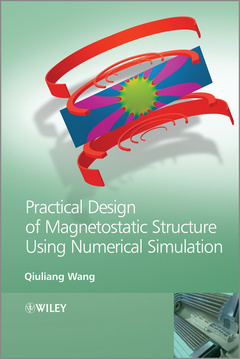Practical Design of Magnetostatic Structure Using Numerical Simulation
Auteur : Wang Qiuliang

- Presents a clear introduction to magnet technology, followed by basic theories, numerical analysis, and practical applications
- Emphasizes the latest developments in magnet design, including MRI systems
- Provides comprehensive numerical techniques that provide solutions to practical problems
- Introduces the latest computation techniques for optimizing and characterizing the magnetostatic structure design
- Well organized and adaptable by researchers, engineers, lecturers, and students
- Appendix available on the Wiley Companion Website
As a comprehensive treatment of the topic, Practical Design of Magnetostatic Structure Using Numerical Simulation is ideal for researchers in the field of magnets and their applications, materials scientists, structural engineers, and graduate students in electrical engineering. The book will also better equip mechanical engineers and aerospace engineers.
Preface xiii
1 Introduction to Magnet Technology 1
1.1 Magnet Classification 1
1.2 Scientific Discoveries in High Magnetic Field 3
1.3 High Field Magnets for Applications 3
1.4 Structure of Magnets 7
1.5 Development Trends in High Field Magnets 10
1.6 Numerical Methods for Magnet Design 12
1.7 Summary 14
References 14
2 Magnetostatic Equations for the Magnet Structure 17
2.1 Basic Law of Macroscopic Electromagnetic Phenomena 17
2.2 Mathematical Basis of Classical Electromagnetic Theory 20
2.3 Equations of Magnetostatic Fields 25
2.4 Summary 37
References 37
3 Finite Element Analysis for the Magnetostatic Field 39
3.1 Introduction 39
3.2 Functional Construction for Static Magnetic Field 41
3.3 Discretization and Interpolation Function of Solution Domain 44
3.4 Formulation of System Equations 68
3.5 Solution of System Equation for the FEM 74
3.6 Applied FEM for Magnet Design 76
3.7 Summary 87
References 87
4 Integral Method for the Magnetostatic Field 89
4.1 Integral Equation of Static Magnetic Field 89
4.2 Magnetic Field from Current-Carrying Conductor 91
4.3 Magnetic Field with Anisotropic Magnetization 128
4.4 Case Studies of Complex Coil Structures 139
4.5 Summary 142
References 142
5 Numerical Methods for Solenoid Coil Design 145
5.1 Magnet Materials and Performance 145
5.2 Magnetic Field of the Superconducting Solenoid 156
5.3 Design of Resistive Magnets 181
5.4 Engineering Design for Superconducting Magnets 186
5.5 Summary 201
References 201
6 Series Analysis of Axially Symmetric Magnetic Field 205
6.1 Laplace’s Equation in Spherical Coordinates 205
6.2 Series Expression of the Boundary-Value Problem 223
6.3 Magnetic Induction of Helical Coils 242
6.4 Magnetic Field of Multi-Coil Combination 247
6.5 Applied Magnetic Field Series Expansion 249
6.6 Summary 261
References 261
7 High Field Magnet with High Homogeneity 263
7.1 Definition of Magnetic Field Homogeneity 263
7.2 Requirements for Magnets with High Homogeneity 264
Applications 264
Magnet 269
7.3 Design of High Homogeneity Magnet 271
7.4 Design Example of High Homogeneity Magnet 290
7.5 Design of High Field and High Homogeneity Magnet 305
7.6 Engineering Designs and Applications 309
7.7 Summary 317
References 318
8 Permanent Magnets and their Applications 321
8.1 Introduction to Magnetic Materials 321
8.2 Classification and Characteristics of Permanent Magnets 324
8.3 Permanent Magnet Structure Design 331
8.4 Design of Magnet for Engineering Applications 341
8.5 Summary 364
References 365
9 Shimming Magnetic Field 367
9.1 Magnetostatic Principle for Shimming Magnetic Field 367
9.2 Design Method for Active Shimming Coil 372
9.3 Current Calculation for Active Shim Coils 411
9.4 Passive Shimming Design Method 414
9.5 Summary 420
References 420
10 Electromechanical Effects and Forces on the Magnet 423
10.1 Magnetostatic Electromechanical Effects on the Solenoid 423
10.2 Averaged Model of the Magnet 435
10.3 Detailed FEM for the Ultrahigh Field Solenoid 445
10.4 Mutual Inductance and Force Calculations 459
10.5 Detailed Model for Electromechanical Stress Analysis 462
10.6 Summary 472
References 473
Index 477
Qiuliang Wang
Institute of electrical Engineering, Chinese Academy of Sciences, China
Date de parution : 07-2013
Ouvrage de 496 p.
17.5x25.3 cm
Thème de Practical Design of Magnetostatic Structure Using... :
Mots-clés :
magnets; industry; instruments; scientific; basic; research; tools; devices; analysis; magnetic; methods; practical; field; optimization; mathematical; numerical; applications; necessary; professional researchers; traditional


